MANM4000 Introduction to Management: Analyzing Leadership Case
VerifiedAdded on 2023/06/15
|8
|2090
|420
Case Study
AI Summary
This assignment provides a comprehensive analysis of a management case study, focusing on leadership challenges and organizational behavior within D7 Displays. It identifies key managerial issues such as biased selection, lack of motivation, and unprofessional behavior, and discusses their negative impact on organizational performance. The solution explores relevant motivational theories, including Herzberg’s dual-factor theory and Maslow’s hierarchy of needs, to address employee de-motivation. Furthermore, it applies human resource theories related to recruitment, selection, and performance management to improve overall efficiency. Finally, the assignment examines different leadership styles, advocating for a democratic approach to foster employee empowerment and enhance team performance. Desklib offers a wealth of similar resources for students.
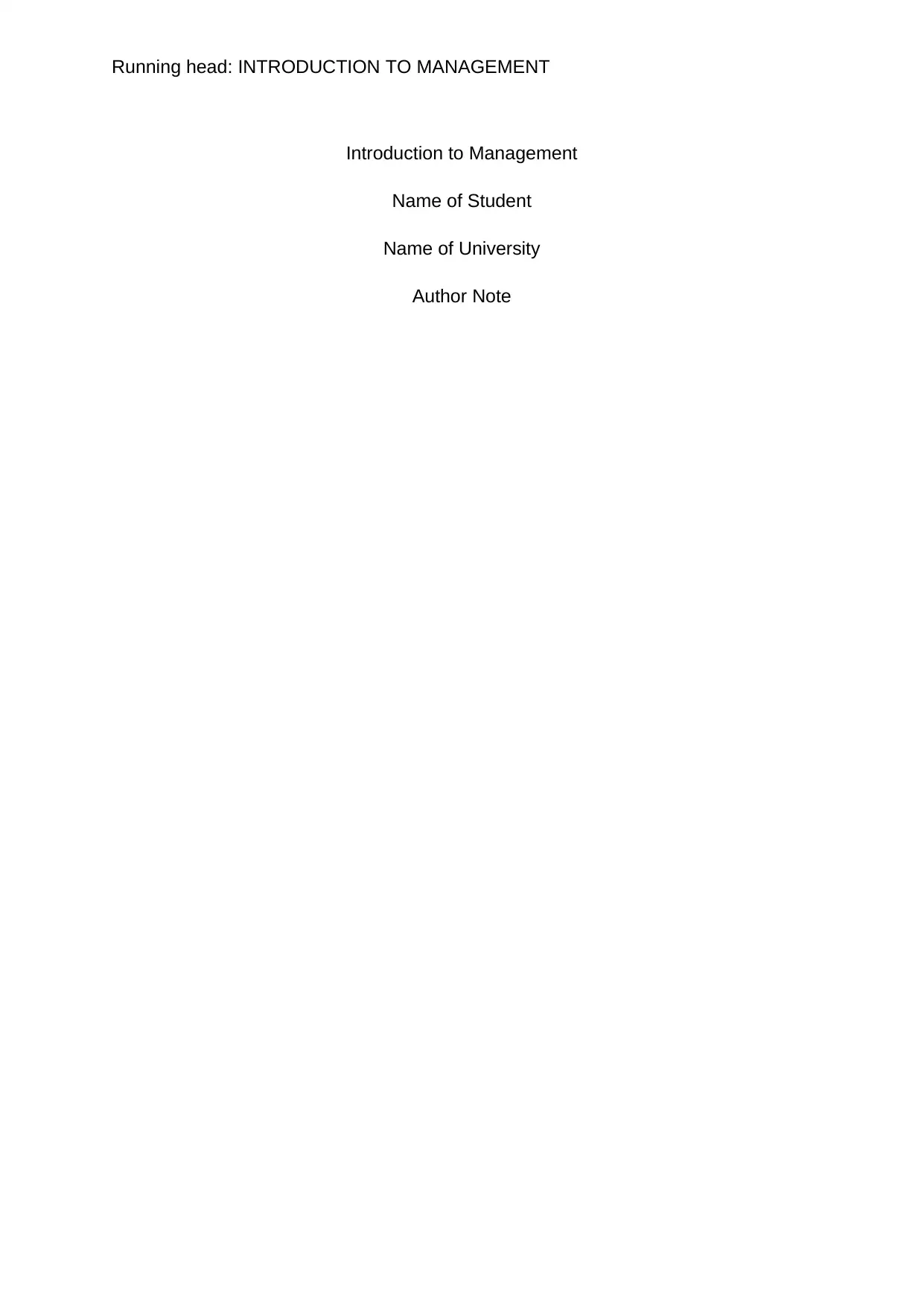
Running head: INTRODUCTION TO MANAGEMENT
Introduction to Management
Name of Student
Name of University
Author Note
Introduction to Management
Name of Student
Name of University
Author Note
Paraphrase This Document
Need a fresh take? Get an instant paraphrase of this document with our AI Paraphraser
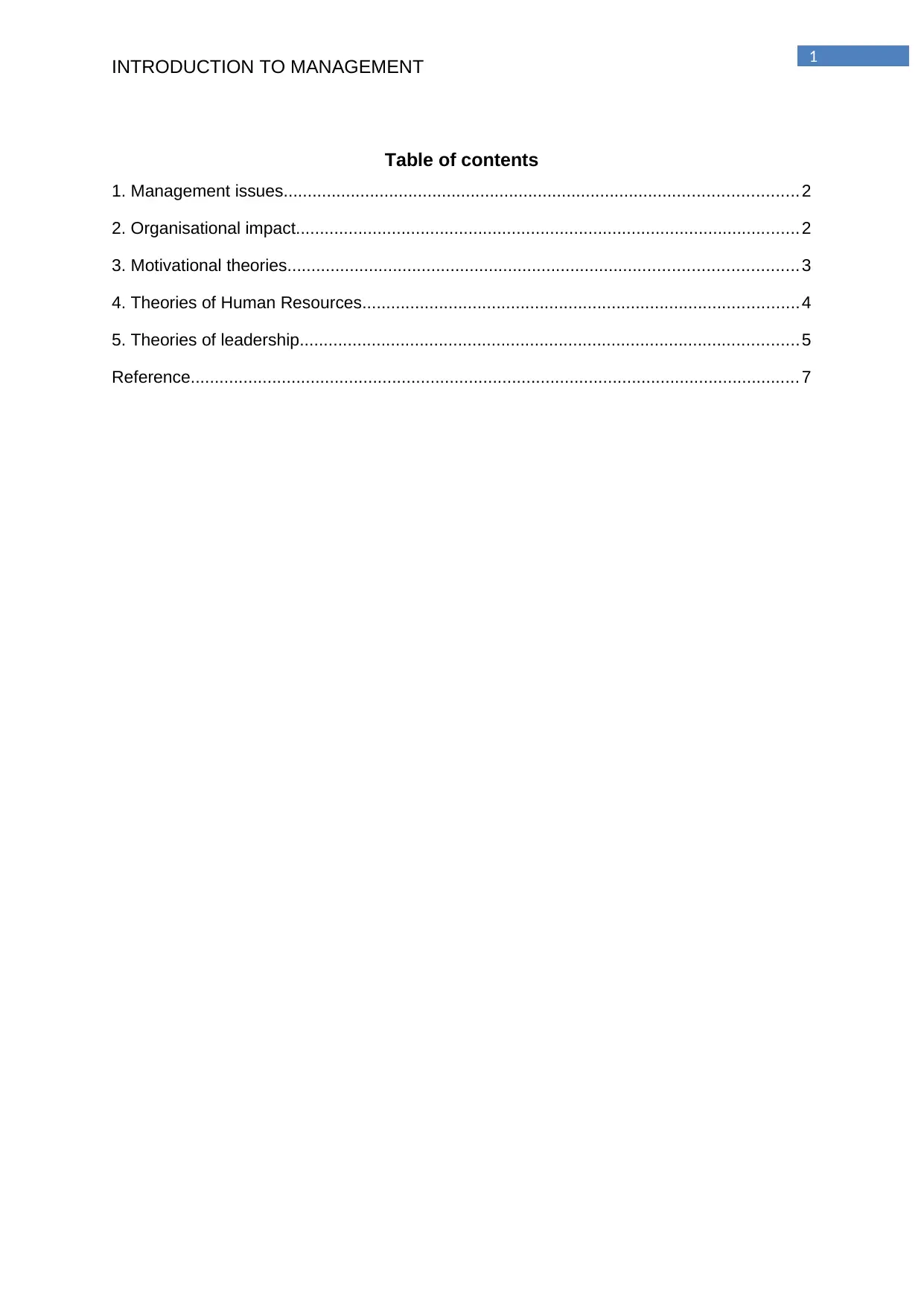
1
INTRODUCTION TO MANAGEMENT
Table of contents
1. Management issues........................................................................................................... 2
2. Organisational impact.........................................................................................................2
3. Motivational theories.......................................................................................................... 3
4. Theories of Human Resources...........................................................................................4
5. Theories of leadership........................................................................................................5
Reference............................................................................................................................... 7
INTRODUCTION TO MANAGEMENT
Table of contents
1. Management issues........................................................................................................... 2
2. Organisational impact.........................................................................................................2
3. Motivational theories.......................................................................................................... 3
4. Theories of Human Resources...........................................................................................4
5. Theories of leadership........................................................................................................5
Reference............................................................................................................................... 7
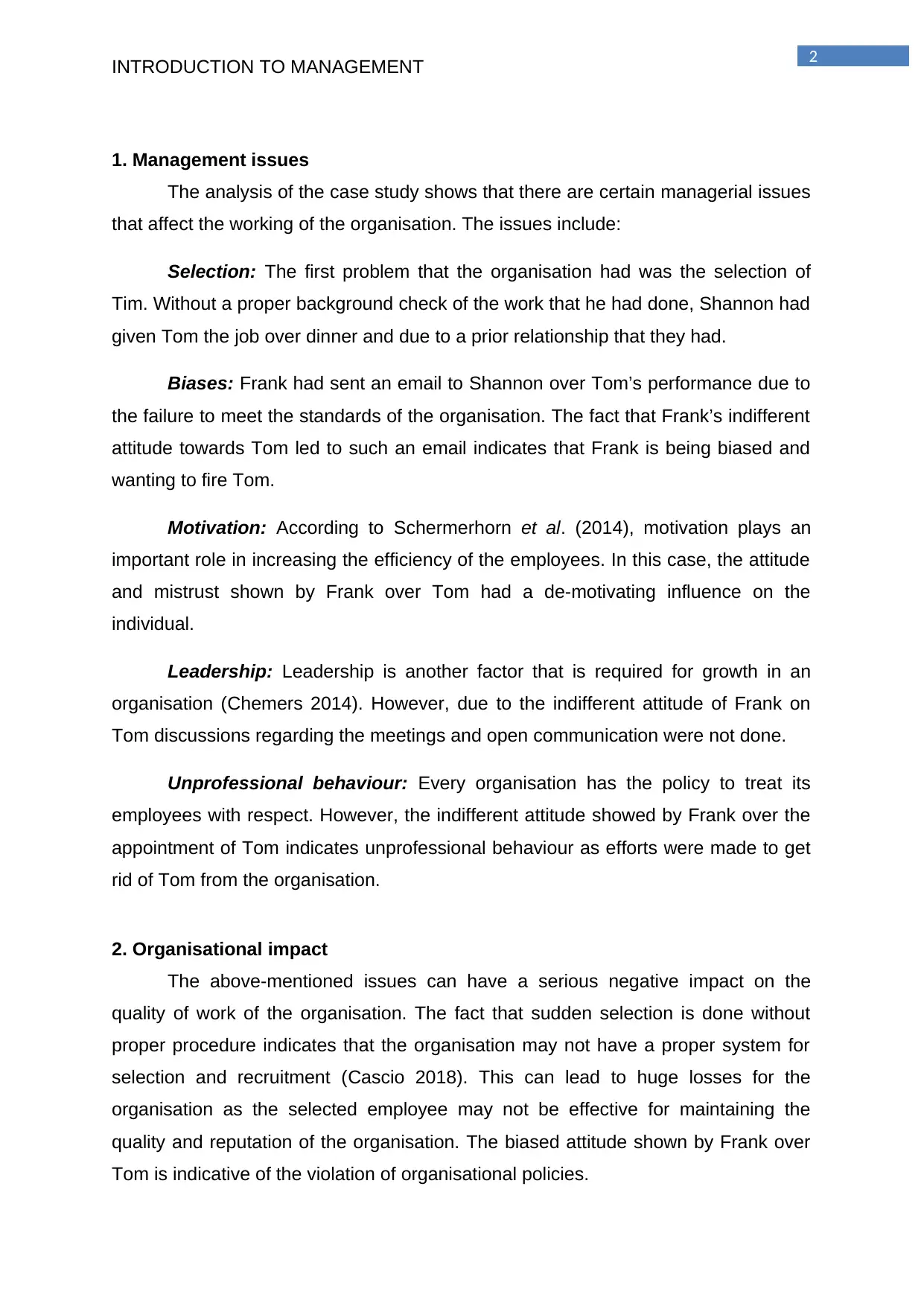
2
INTRODUCTION TO MANAGEMENT
1. Management issues
The analysis of the case study shows that there are certain managerial issues
that affect the working of the organisation. The issues include:
Selection: The first problem that the organisation had was the selection of
Tim. Without a proper background check of the work that he had done, Shannon had
given Tom the job over dinner and due to a prior relationship that they had.
Biases: Frank had sent an email to Shannon over Tom’s performance due to
the failure to meet the standards of the organisation. The fact that Frank’s indifferent
attitude towards Tom led to such an email indicates that Frank is being biased and
wanting to fire Tom.
Motivation: According to Schermerhorn et al. (2014), motivation plays an
important role in increasing the efficiency of the employees. In this case, the attitude
and mistrust shown by Frank over Tom had a de-motivating influence on the
individual.
Leadership: Leadership is another factor that is required for growth in an
organisation (Chemers 2014). However, due to the indifferent attitude of Frank on
Tom discussions regarding the meetings and open communication were not done.
Unprofessional behaviour: Every organisation has the policy to treat its
employees with respect. However, the indifferent attitude showed by Frank over the
appointment of Tom indicates unprofessional behaviour as efforts were made to get
rid of Tom from the organisation.
2. Organisational impact
The above-mentioned issues can have a serious negative impact on the
quality of work of the organisation. The fact that sudden selection is done without
proper procedure indicates that the organisation may not have a proper system for
selection and recruitment (Cascio 2018). This can lead to huge losses for the
organisation as the selected employee may not be effective for maintaining the
quality and reputation of the organisation. The biased attitude shown by Frank over
Tom is indicative of the violation of organisational policies.
INTRODUCTION TO MANAGEMENT
1. Management issues
The analysis of the case study shows that there are certain managerial issues
that affect the working of the organisation. The issues include:
Selection: The first problem that the organisation had was the selection of
Tim. Without a proper background check of the work that he had done, Shannon had
given Tom the job over dinner and due to a prior relationship that they had.
Biases: Frank had sent an email to Shannon over Tom’s performance due to
the failure to meet the standards of the organisation. The fact that Frank’s indifferent
attitude towards Tom led to such an email indicates that Frank is being biased and
wanting to fire Tom.
Motivation: According to Schermerhorn et al. (2014), motivation plays an
important role in increasing the efficiency of the employees. In this case, the attitude
and mistrust shown by Frank over Tom had a de-motivating influence on the
individual.
Leadership: Leadership is another factor that is required for growth in an
organisation (Chemers 2014). However, due to the indifferent attitude of Frank on
Tom discussions regarding the meetings and open communication were not done.
Unprofessional behaviour: Every organisation has the policy to treat its
employees with respect. However, the indifferent attitude showed by Frank over the
appointment of Tom indicates unprofessional behaviour as efforts were made to get
rid of Tom from the organisation.
2. Organisational impact
The above-mentioned issues can have a serious negative impact on the
quality of work of the organisation. The fact that sudden selection is done without
proper procedure indicates that the organisation may not have a proper system for
selection and recruitment (Cascio 2018). This can lead to huge losses for the
organisation as the selected employee may not be effective for maintaining the
quality and reputation of the organisation. The biased attitude shown by Frank over
Tom is indicative of the violation of organisational policies.
⊘ This is a preview!⊘
Do you want full access?
Subscribe today to unlock all pages.

Trusted by 1+ million students worldwide
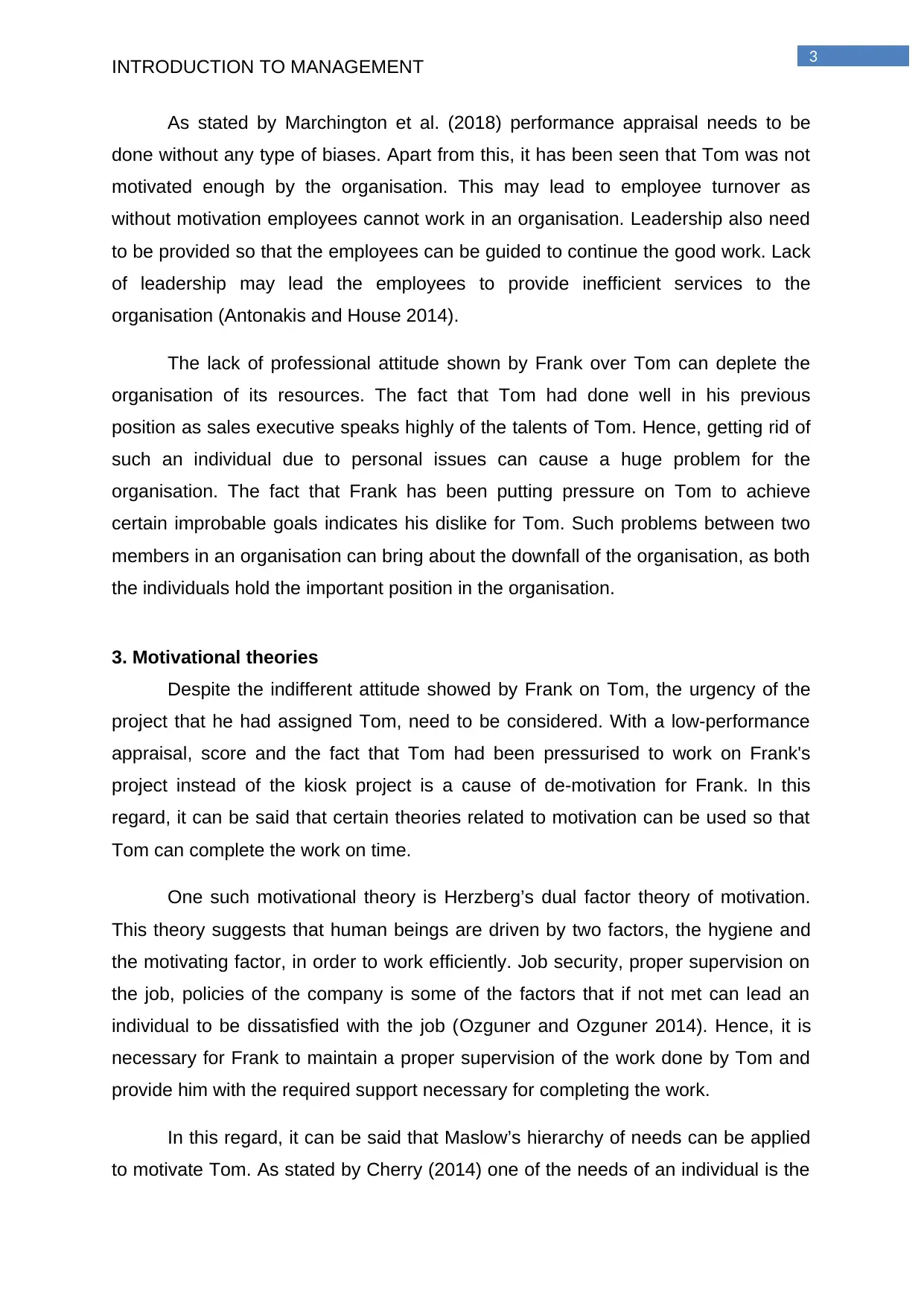
3
INTRODUCTION TO MANAGEMENT
As stated by Marchington et al. (2018) performance appraisal needs to be
done without any type of biases. Apart from this, it has been seen that Tom was not
motivated enough by the organisation. This may lead to employee turnover as
without motivation employees cannot work in an organisation. Leadership also need
to be provided so that the employees can be guided to continue the good work. Lack
of leadership may lead the employees to provide inefficient services to the
organisation (Antonakis and House 2014).
The lack of professional attitude shown by Frank over Tom can deplete the
organisation of its resources. The fact that Tom had done well in his previous
position as sales executive speaks highly of the talents of Tom. Hence, getting rid of
such an individual due to personal issues can cause a huge problem for the
organisation. The fact that Frank has been putting pressure on Tom to achieve
certain improbable goals indicates his dislike for Tom. Such problems between two
members in an organisation can bring about the downfall of the organisation, as both
the individuals hold the important position in the organisation.
3. Motivational theories
Despite the indifferent attitude showed by Frank on Tom, the urgency of the
project that he had assigned Tom, need to be considered. With a low-performance
appraisal, score and the fact that Tom had been pressurised to work on Frank's
project instead of the kiosk project is a cause of de-motivation for Frank. In this
regard, it can be said that certain theories related to motivation can be used so that
Tom can complete the work on time.
One such motivational theory is Herzberg’s dual factor theory of motivation.
This theory suggests that human beings are driven by two factors, the hygiene and
the motivating factor, in order to work efficiently. Job security, proper supervision on
the job, policies of the company is some of the factors that if not met can lead an
individual to be dissatisfied with the job (Ozguner and Ozguner 2014). Hence, it is
necessary for Frank to maintain a proper supervision of the work done by Tom and
provide him with the required support necessary for completing the work.
In this regard, it can be said that Maslow’s hierarchy of needs can be applied
to motivate Tom. As stated by Cherry (2014) one of the needs of an individual is the
INTRODUCTION TO MANAGEMENT
As stated by Marchington et al. (2018) performance appraisal needs to be
done without any type of biases. Apart from this, it has been seen that Tom was not
motivated enough by the organisation. This may lead to employee turnover as
without motivation employees cannot work in an organisation. Leadership also need
to be provided so that the employees can be guided to continue the good work. Lack
of leadership may lead the employees to provide inefficient services to the
organisation (Antonakis and House 2014).
The lack of professional attitude shown by Frank over Tom can deplete the
organisation of its resources. The fact that Tom had done well in his previous
position as sales executive speaks highly of the talents of Tom. Hence, getting rid of
such an individual due to personal issues can cause a huge problem for the
organisation. The fact that Frank has been putting pressure on Tom to achieve
certain improbable goals indicates his dislike for Tom. Such problems between two
members in an organisation can bring about the downfall of the organisation, as both
the individuals hold the important position in the organisation.
3. Motivational theories
Despite the indifferent attitude showed by Frank on Tom, the urgency of the
project that he had assigned Tom, need to be considered. With a low-performance
appraisal, score and the fact that Tom had been pressurised to work on Frank's
project instead of the kiosk project is a cause of de-motivation for Frank. In this
regard, it can be said that certain theories related to motivation can be used so that
Tom can complete the work on time.
One such motivational theory is Herzberg’s dual factor theory of motivation.
This theory suggests that human beings are driven by two factors, the hygiene and
the motivating factor, in order to work efficiently. Job security, proper supervision on
the job, policies of the company is some of the factors that if not met can lead an
individual to be dissatisfied with the job (Ozguner and Ozguner 2014). Hence, it is
necessary for Frank to maintain a proper supervision of the work done by Tom and
provide him with the required support necessary for completing the work.
In this regard, it can be said that Maslow’s hierarchy of needs can be applied
to motivate Tom. As stated by Cherry (2014) one of the needs of an individual is the
Paraphrase This Document
Need a fresh take? Get an instant paraphrase of this document with our AI Paraphraser
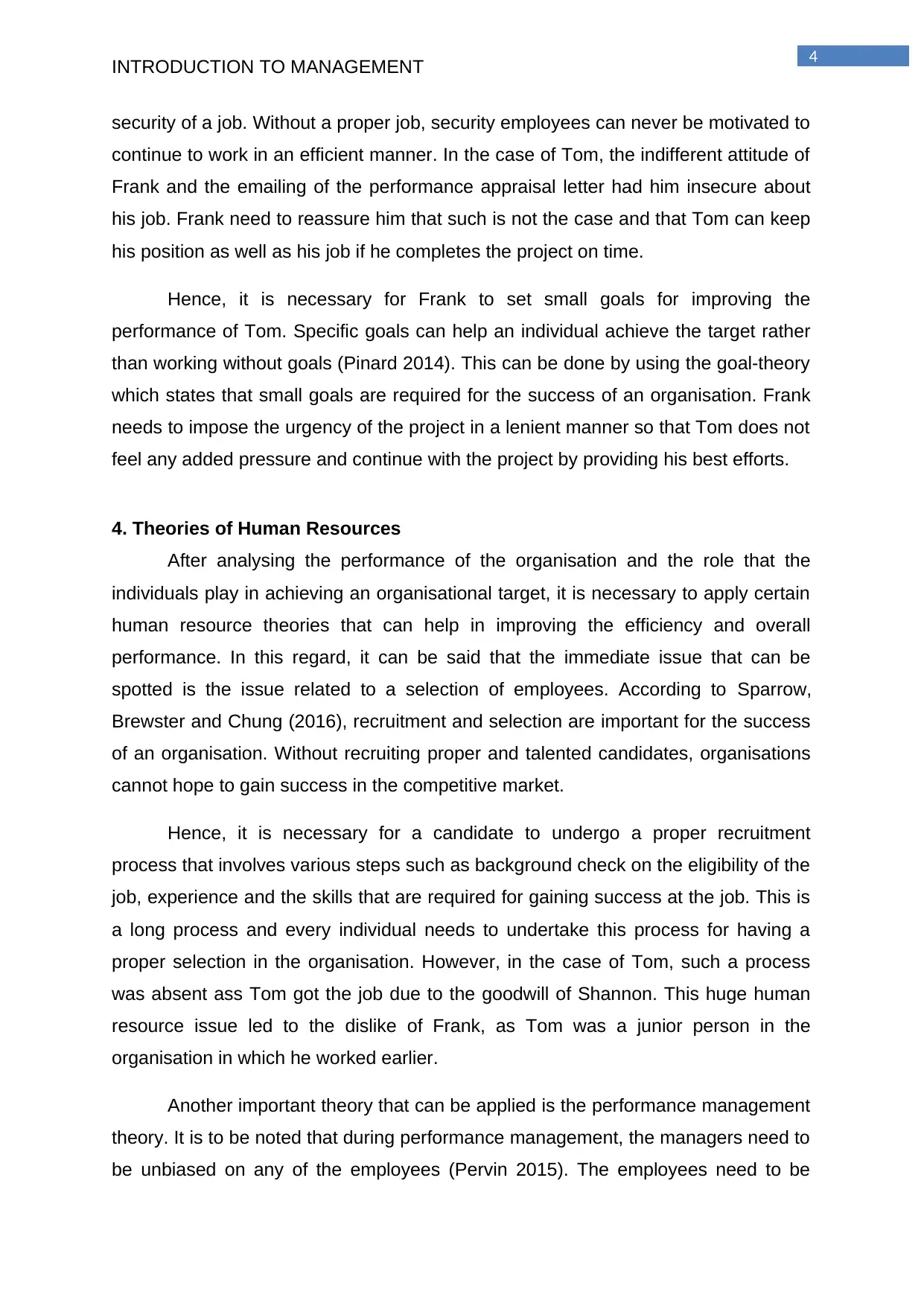
4
INTRODUCTION TO MANAGEMENT
security of a job. Without a proper job, security employees can never be motivated to
continue to work in an efficient manner. In the case of Tom, the indifferent attitude of
Frank and the emailing of the performance appraisal letter had him insecure about
his job. Frank need to reassure him that such is not the case and that Tom can keep
his position as well as his job if he completes the project on time.
Hence, it is necessary for Frank to set small goals for improving the
performance of Tom. Specific goals can help an individual achieve the target rather
than working without goals (Pinard 2014). This can be done by using the goal-theory
which states that small goals are required for the success of an organisation. Frank
needs to impose the urgency of the project in a lenient manner so that Tom does not
feel any added pressure and continue with the project by providing his best efforts.
4. Theories of Human Resources
After analysing the performance of the organisation and the role that the
individuals play in achieving an organisational target, it is necessary to apply certain
human resource theories that can help in improving the efficiency and overall
performance. In this regard, it can be said that the immediate issue that can be
spotted is the issue related to a selection of employees. According to Sparrow,
Brewster and Chung (2016), recruitment and selection are important for the success
of an organisation. Without recruiting proper and talented candidates, organisations
cannot hope to gain success in the competitive market.
Hence, it is necessary for a candidate to undergo a proper recruitment
process that involves various steps such as background check on the eligibility of the
job, experience and the skills that are required for gaining success at the job. This is
a long process and every individual needs to undertake this process for having a
proper selection in the organisation. However, in the case of Tom, such a process
was absent ass Tom got the job due to the goodwill of Shannon. This huge human
resource issue led to the dislike of Frank, as Tom was a junior person in the
organisation in which he worked earlier.
Another important theory that can be applied is the performance management
theory. It is to be noted that during performance management, the managers need to
be unbiased on any of the employees (Pervin 2015). The employees need to be
INTRODUCTION TO MANAGEMENT
security of a job. Without a proper job, security employees can never be motivated to
continue to work in an efficient manner. In the case of Tom, the indifferent attitude of
Frank and the emailing of the performance appraisal letter had him insecure about
his job. Frank need to reassure him that such is not the case and that Tom can keep
his position as well as his job if he completes the project on time.
Hence, it is necessary for Frank to set small goals for improving the
performance of Tom. Specific goals can help an individual achieve the target rather
than working without goals (Pinard 2014). This can be done by using the goal-theory
which states that small goals are required for the success of an organisation. Frank
needs to impose the urgency of the project in a lenient manner so that Tom does not
feel any added pressure and continue with the project by providing his best efforts.
4. Theories of Human Resources
After analysing the performance of the organisation and the role that the
individuals play in achieving an organisational target, it is necessary to apply certain
human resource theories that can help in improving the efficiency and overall
performance. In this regard, it can be said that the immediate issue that can be
spotted is the issue related to a selection of employees. According to Sparrow,
Brewster and Chung (2016), recruitment and selection are important for the success
of an organisation. Without recruiting proper and talented candidates, organisations
cannot hope to gain success in the competitive market.
Hence, it is necessary for a candidate to undergo a proper recruitment
process that involves various steps such as background check on the eligibility of the
job, experience and the skills that are required for gaining success at the job. This is
a long process and every individual needs to undertake this process for having a
proper selection in the organisation. However, in the case of Tom, such a process
was absent ass Tom got the job due to the goodwill of Shannon. This huge human
resource issue led to the dislike of Frank, as Tom was a junior person in the
organisation in which he worked earlier.
Another important theory that can be applied is the performance management
theory. It is to be noted that during performance management, the managers need to
be unbiased on any of the employees (Pervin 2015). The employees need to be
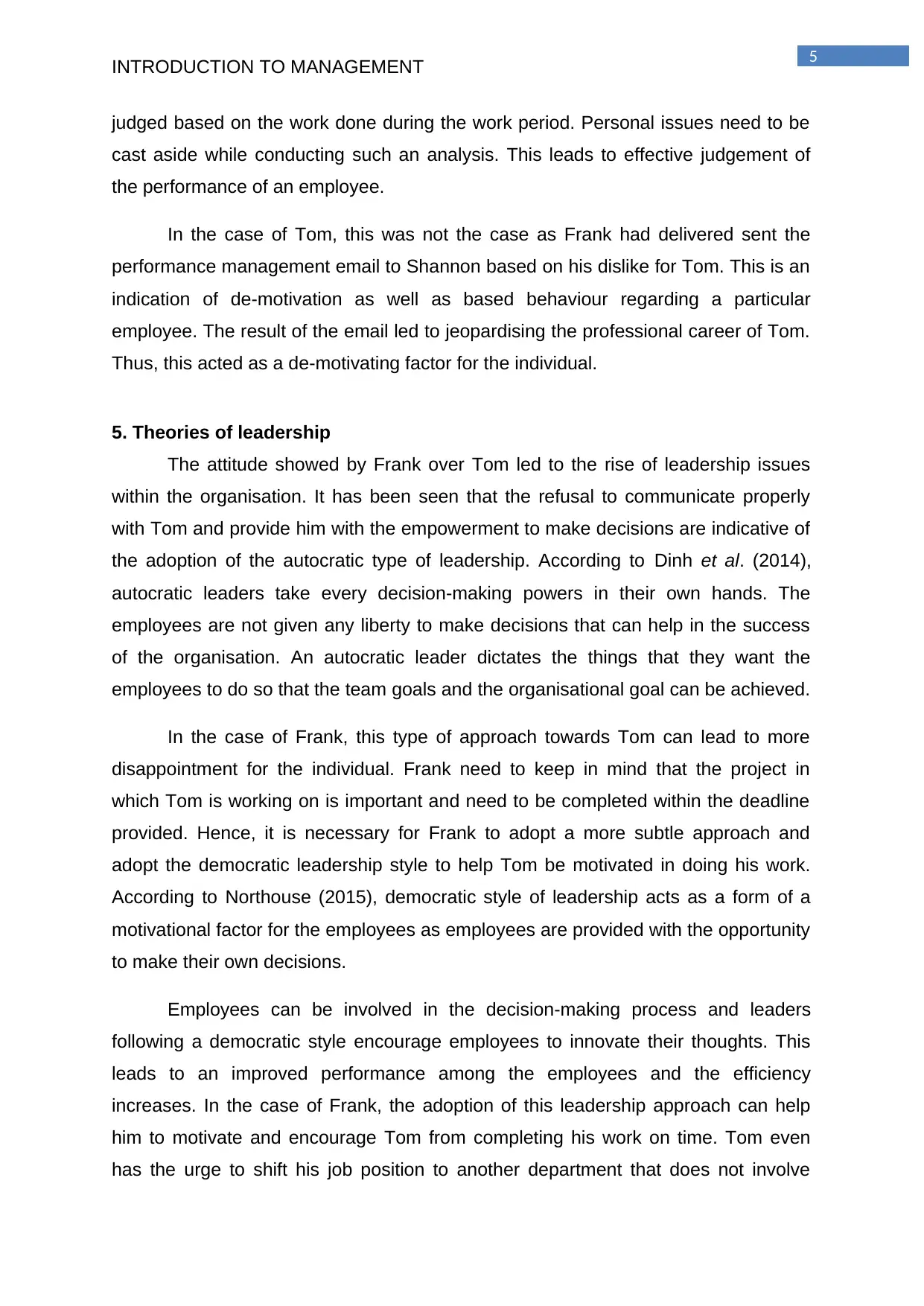
5
INTRODUCTION TO MANAGEMENT
judged based on the work done during the work period. Personal issues need to be
cast aside while conducting such an analysis. This leads to effective judgement of
the performance of an employee.
In the case of Tom, this was not the case as Frank had delivered sent the
performance management email to Shannon based on his dislike for Tom. This is an
indication of de-motivation as well as based behaviour regarding a particular
employee. The result of the email led to jeopardising the professional career of Tom.
Thus, this acted as a de-motivating factor for the individual.
5. Theories of leadership
The attitude showed by Frank over Tom led to the rise of leadership issues
within the organisation. It has been seen that the refusal to communicate properly
with Tom and provide him with the empowerment to make decisions are indicative of
the adoption of the autocratic type of leadership. According to Dinh et al. (2014),
autocratic leaders take every decision-making powers in their own hands. The
employees are not given any liberty to make decisions that can help in the success
of the organisation. An autocratic leader dictates the things that they want the
employees to do so that the team goals and the organisational goal can be achieved.
In the case of Frank, this type of approach towards Tom can lead to more
disappointment for the individual. Frank need to keep in mind that the project in
which Tom is working on is important and need to be completed within the deadline
provided. Hence, it is necessary for Frank to adopt a more subtle approach and
adopt the democratic leadership style to help Tom be motivated in doing his work.
According to Northouse (2015), democratic style of leadership acts as a form of a
motivational factor for the employees as employees are provided with the opportunity
to make their own decisions.
Employees can be involved in the decision-making process and leaders
following a democratic style encourage employees to innovate their thoughts. This
leads to an improved performance among the employees and the efficiency
increases. In the case of Frank, the adoption of this leadership approach can help
him to motivate and encourage Tom from completing his work on time. Tom even
has the urge to shift his job position to another department that does not involve
INTRODUCTION TO MANAGEMENT
judged based on the work done during the work period. Personal issues need to be
cast aside while conducting such an analysis. This leads to effective judgement of
the performance of an employee.
In the case of Tom, this was not the case as Frank had delivered sent the
performance management email to Shannon based on his dislike for Tom. This is an
indication of de-motivation as well as based behaviour regarding a particular
employee. The result of the email led to jeopardising the professional career of Tom.
Thus, this acted as a de-motivating factor for the individual.
5. Theories of leadership
The attitude showed by Frank over Tom led to the rise of leadership issues
within the organisation. It has been seen that the refusal to communicate properly
with Tom and provide him with the empowerment to make decisions are indicative of
the adoption of the autocratic type of leadership. According to Dinh et al. (2014),
autocratic leaders take every decision-making powers in their own hands. The
employees are not given any liberty to make decisions that can help in the success
of the organisation. An autocratic leader dictates the things that they want the
employees to do so that the team goals and the organisational goal can be achieved.
In the case of Frank, this type of approach towards Tom can lead to more
disappointment for the individual. Frank need to keep in mind that the project in
which Tom is working on is important and need to be completed within the deadline
provided. Hence, it is necessary for Frank to adopt a more subtle approach and
adopt the democratic leadership style to help Tom be motivated in doing his work.
According to Northouse (2015), democratic style of leadership acts as a form of a
motivational factor for the employees as employees are provided with the opportunity
to make their own decisions.
Employees can be involved in the decision-making process and leaders
following a democratic style encourage employees to innovate their thoughts. This
leads to an improved performance among the employees and the efficiency
increases. In the case of Frank, the adoption of this leadership approach can help
him to motivate and encourage Tom from completing his work on time. Tom even
has the urge to shift his job position to another department that does not involve
⊘ This is a preview!⊘
Do you want full access?
Subscribe today to unlock all pages.

Trusted by 1+ million students worldwide

6
INTRODUCTION TO MANAGEMENT
Frank as a leader. Hence, to prevent such issues it is necessary for Frank to change
his style of leadership.
INTRODUCTION TO MANAGEMENT
Frank as a leader. Hence, to prevent such issues it is necessary for Frank to change
his style of leadership.
Paraphrase This Document
Need a fresh take? Get an instant paraphrase of this document with our AI Paraphraser
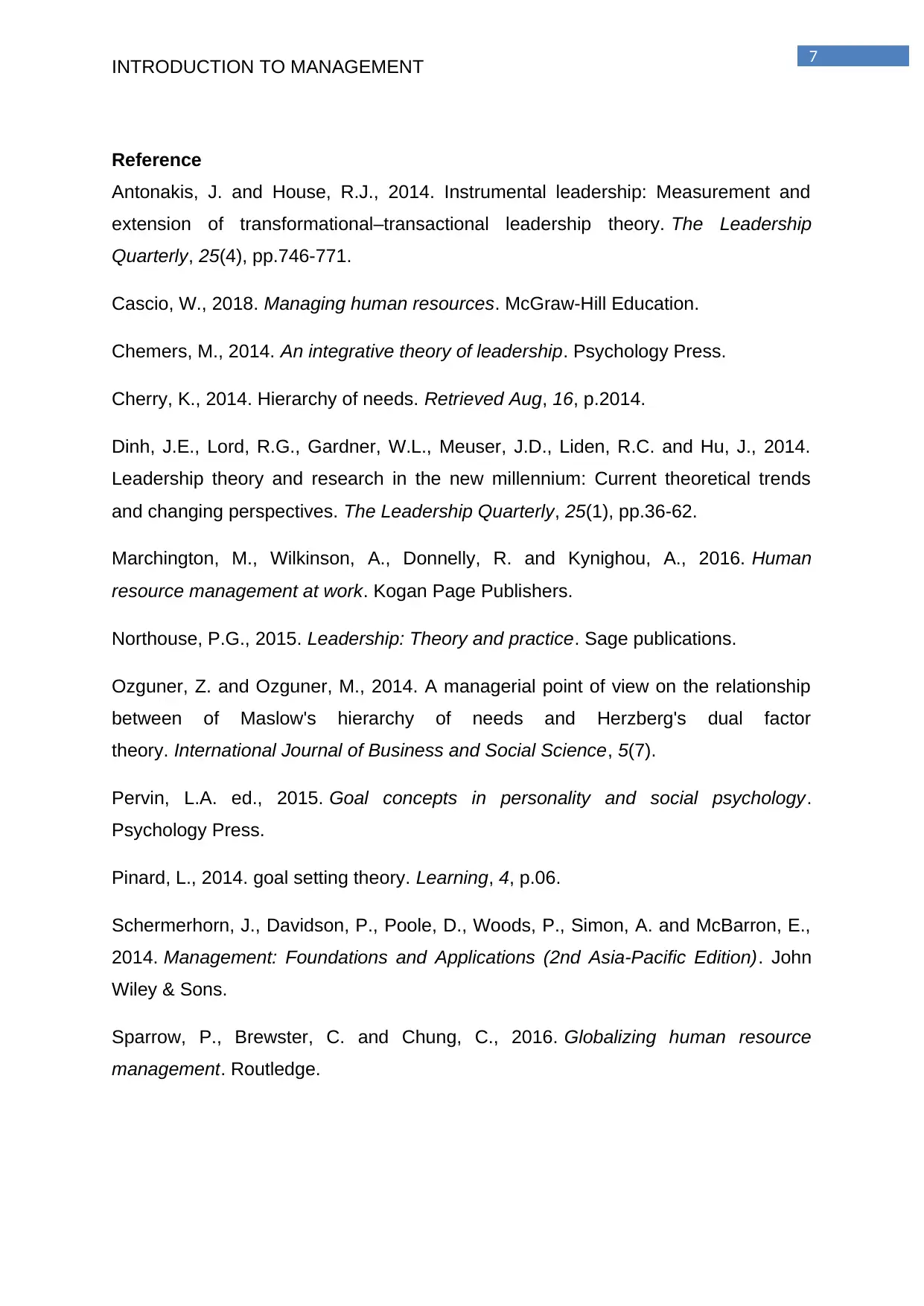
7
INTRODUCTION TO MANAGEMENT
Reference
Antonakis, J. and House, R.J., 2014. Instrumental leadership: Measurement and
extension of transformational–transactional leadership theory. The Leadership
Quarterly, 25(4), pp.746-771.
Cascio, W., 2018. Managing human resources. McGraw-Hill Education.
Chemers, M., 2014. An integrative theory of leadership. Psychology Press.
Cherry, K., 2014. Hierarchy of needs. Retrieved Aug, 16, p.2014.
Dinh, J.E., Lord, R.G., Gardner, W.L., Meuser, J.D., Liden, R.C. and Hu, J., 2014.
Leadership theory and research in the new millennium: Current theoretical trends
and changing perspectives. The Leadership Quarterly, 25(1), pp.36-62.
Marchington, M., Wilkinson, A., Donnelly, R. and Kynighou, A., 2016. Human
resource management at work. Kogan Page Publishers.
Northouse, P.G., 2015. Leadership: Theory and practice. Sage publications.
Ozguner, Z. and Ozguner, M., 2014. A managerial point of view on the relationship
between of Maslow's hierarchy of needs and Herzberg's dual factor
theory. International Journal of Business and Social Science, 5(7).
Pervin, L.A. ed., 2015. Goal concepts in personality and social psychology.
Psychology Press.
Pinard, L., 2014. goal setting theory. Learning, 4, p.06.
Schermerhorn, J., Davidson, P., Poole, D., Woods, P., Simon, A. and McBarron, E.,
2014. Management: Foundations and Applications (2nd Asia-Pacific Edition). John
Wiley & Sons.
Sparrow, P., Brewster, C. and Chung, C., 2016. Globalizing human resource
management. Routledge.
INTRODUCTION TO MANAGEMENT
Reference
Antonakis, J. and House, R.J., 2014. Instrumental leadership: Measurement and
extension of transformational–transactional leadership theory. The Leadership
Quarterly, 25(4), pp.746-771.
Cascio, W., 2018. Managing human resources. McGraw-Hill Education.
Chemers, M., 2014. An integrative theory of leadership. Psychology Press.
Cherry, K., 2014. Hierarchy of needs. Retrieved Aug, 16, p.2014.
Dinh, J.E., Lord, R.G., Gardner, W.L., Meuser, J.D., Liden, R.C. and Hu, J., 2014.
Leadership theory and research in the new millennium: Current theoretical trends
and changing perspectives. The Leadership Quarterly, 25(1), pp.36-62.
Marchington, M., Wilkinson, A., Donnelly, R. and Kynighou, A., 2016. Human
resource management at work. Kogan Page Publishers.
Northouse, P.G., 2015. Leadership: Theory and practice. Sage publications.
Ozguner, Z. and Ozguner, M., 2014. A managerial point of view on the relationship
between of Maslow's hierarchy of needs and Herzberg's dual factor
theory. International Journal of Business and Social Science, 5(7).
Pervin, L.A. ed., 2015. Goal concepts in personality and social psychology.
Psychology Press.
Pinard, L., 2014. goal setting theory. Learning, 4, p.06.
Schermerhorn, J., Davidson, P., Poole, D., Woods, P., Simon, A. and McBarron, E.,
2014. Management: Foundations and Applications (2nd Asia-Pacific Edition). John
Wiley & Sons.
Sparrow, P., Brewster, C. and Chung, C., 2016. Globalizing human resource
management. Routledge.
1 out of 8
Related Documents
Your All-in-One AI-Powered Toolkit for Academic Success.
+13062052269
info@desklib.com
Available 24*7 on WhatsApp / Email
![[object Object]](/_next/static/media/star-bottom.7253800d.svg)
Unlock your academic potential
Copyright © 2020–2025 A2Z Services. All Rights Reserved. Developed and managed by ZUCOL.





